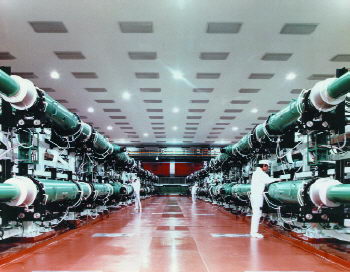|
Laser physicists
in Europe have put forward plans to build a ?500m facility to study a new
approach to laser fusion. A panel of scientists from seven European Union
countries believes that a "fast ignition" laser facility could make a
significant contribution to fusion research, as well as supporting experiments
in other areas of physics. The facility could be up and running by the middle of
the next decade.
The laser would be
used to compress and heat a small capsule of deuterium and tritium until the
nuclei are hot enough to undergo nuclear fusion and produce helium and neutrons.
In a reactor the energy of the neutrons would be used to generate electricity
without the emission of greenhouse gases or the generation of long-lived nuclear
waste.
The most advanced
approach to fusion involves using magnetic fields to confine the deuterium–tritium
plasma. This is the route to be taken by ITER, which will cost $10bn to build
and run. The alternative "inertial confinement" technique, which uses lasers or
ion beams rather than magnets to confine the plasma, will be investigated by the
National Ignition Facility (NIF) in the US and the Laser M?gajoule (LMJ) in
France. However, both these billion-dollar lasers will primarily be used for
nuclear-weapons research, with only 15% of their time being available for other
areas of physics.

Fast ignition
has been demonstrated using the Gekko XII laser at Osaka University in Japan (image
credit: ILE)
In the conventional
approach to inertial confinement, which will be used at NIF and LMJ, the lasers
that compress the fuel capsule also heat it. Fast ignition, which was first
proposed by Max Tabak of the Lawrence Livermore National Laboratory in the US,
relies on different lasers for these two stages. According to Henry Hutchinson
of the Rutherford Appleton Laboratory in the UK, who set up the European panel,
fast ignition requires less laser energy than the conventional approach, which
means that it is considerably cheaper.
"The energy problem
is sufficiently urgent that we cannot afford to ignore different approaches to
fusion," he says. Hutchinson also stresses that any fast-ignition laser would be
a civilian facility, and would be available for research on astrophysics, atomic
physics and nuclear physics as well.
Fast ignition was
first demonstrated at the Gekko XII laser at Osaka University in Japan in 2001,
working with a team of UK scientists. Kodama and colleagues are now upgrading
their laser system in order to approach "breakeven" - the point at which the
energy output is equal to the energy needed to sustain the reaction. They then
plan to further enhance their system so that it reaches ignition, which happens
when the fusion reactions generate enough energy to sustain themselves without
the need for further heating. Finally, they hope to build a demonstration
fast-ignition facility. Physicists in the US are also studying fast ignition.
HiPER, as the
European proposal is provisionally known, would be designed to achieve high
energy gains, providing the critical intermediate step between ignition and a
demonstration reactor. It would consist of a long-pulse laser with an energy of
200 kJ to compress the fuel and a short-pulse laser with an energy of 70 kJ to
heat it.
If Hutchinson and
colleagues can persuade research councils across Europe to back the proposal,
construction could start around the end of the decade. Although the panel's
report does not discuss where the laser should be built, the UK would be a
contender to host the facility.
Edwin Cartlidge
News Editor of Physics World
Источник; PhysicWeb |



